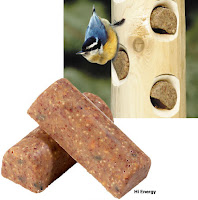 If you have never fed Suet, you may have missed some great birds. Suet is one of the top three foods to feed wild birds. Birds have high metabolic rates. It is not unusual for birds to consume 1/4 to 1/3 their body weight worth of food a day! Offering suet cakes provides a high caloric energy source.
If you have never fed Suet, you may have missed some great birds. Suet is one of the top three foods to feed wild birds. Birds have high metabolic rates. It is not unusual for birds to consume 1/4 to 1/3 their body weight worth of food a day! Offering suet cakes provides a high caloric energy source. Common birds that eat suet are downy, hairy, red-bellied, and pileated woodpeckers. Chickadees, northern flickers, nuthatches, and starlings are also avid suet eaters. By adding Suet to your wild bird's menu, you will also attract wrens, warblers, thrushes, brown creepers, blue jays and even bluebirds if they are in your area.
If it’s cold enough for snow you don’t need to render the suet. You can just put the suet in a feeder or onion bag and let the birds peck at it. In the wild, birds will munch on the fat from dead animals like deer or road kill to get the high calories they require to survive cold weather. But they won’t eat it if it goes rancid.
That’s why most people buy the prepared suet cakes we sell at Wild Birds Unlimited. Our suet cakes are made with only the highest quality processed beef kidney fat. Special processes remove impurities that cause low melting points and spoilage problems. Or you can render suet yourself.
 |
| image via Wikipedia |
1. Chop the fat.
2. Melt the fat on the stove over a low heat
3. Strain melted suet through a fine cheesecloth.
4. Let cool and harden.
5. Repeat steps 2-3. If the fat is not rendered twice, the suet will not harden properly.
6. Pour into a bread pan
7. Slice and serve after suet is hard
You can add peanut butter, dried fruit, nuts or seeds to make a variety of suets.
Other Suet Recipes: http://www.sialis.org/suet.htm
FYI
According to the Cornell Lab of Ornithology “bacon drippings are also animal fat and many birds love the taste. But bacon virtually always has detectable amounts of nitrosamines, carcinogenic compounds formed from some of the preservatives used in bacon. In particular, the very high cooking temperatures used to fry bacon are conducive to nitrosamine formation. So despite the fact that birds love it, bacon and bacon fat pose too much of a risk to the long-term health of birds to warrant using it.”
Category ›
Question of the week
 Unknown
Unknown
 Wednesday, November 10, 2010
Wednesday, November 10, 2010











No comments:
Post a Comment